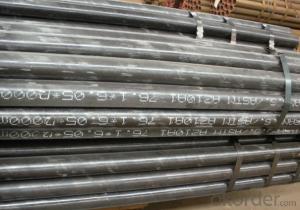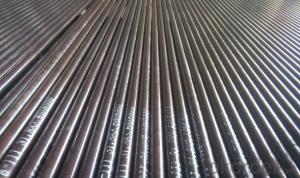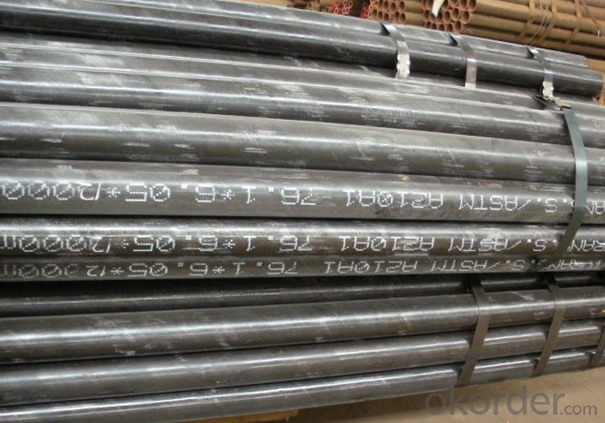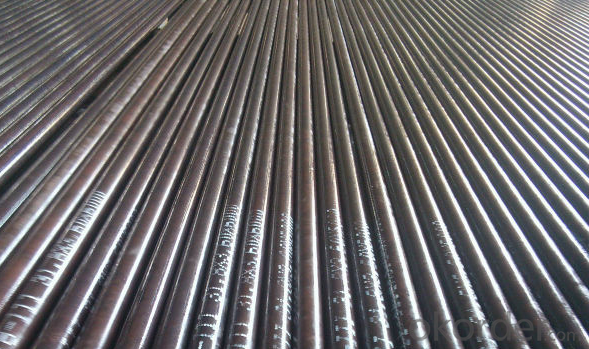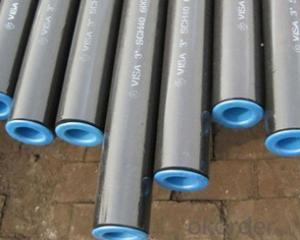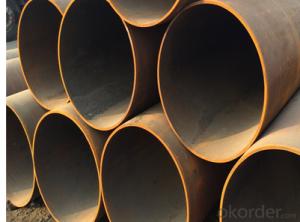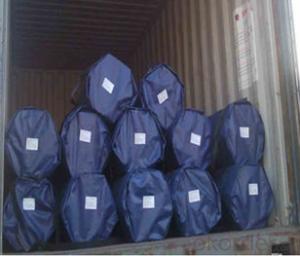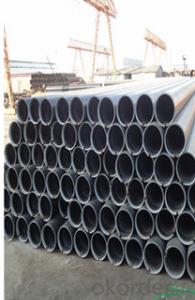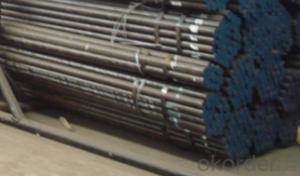Carbon steel seamless pipe for boiler 12Cr1MoV CNBM
- Loading Port:
- Qingdao
- Payment Terms:
- TT OR LC
- Min Order Qty:
- 10 pc
- Supply Capability:
- 30 pc/month
OKorder Service Pledge
OKorder Financial Service
You Might Also Like
Quick Details
| Thickness: | 1.2 - 20 mm | Section Shape: | Round | Outer Diameter: | 12.7 - 168 mm |
| Place of Origin: | Jiangsu China (Mainland) | Secondary Or Not: | Non-secondary | Application: | Boiler Pipe |
| Technique: | Cold Drawn | Certification: | PED | Surface Treatment: | oil coating |
| Special Pipe: | Thick Wall Pipe | Alloy Or Not: | Is Alloy | ASTM A213: | T2,T5,T9,T11,T12,T22,T23,T91,T91 |
| ASTM A335: | P1,P2,P5,P9,P11,P12,P22,P23,P91,P92 | DIN17175: | 15Mo3,10CrMo910,12CrMo195,13CrMo44 | Grade: | 12Cr1MoV,Cr5Mo,Cr9Mo,12Cr1MoVG,Cr5MoG,A335 P11,A335 P5,A335 P9,A335 P1,A213,A192,A210,A335 P12,A335 P23,St35.8,Cr-Mo alloy,A53-A369,ST35-ST52 |
| Standard: | BS 3059-2,DIN EN 10216-1-2004,DIN 17175,ASTM A213-2001,ANSI A210-1996,ASTM A179-1990,BS,DIN,ASTM |
Packaging & Delivery
| Packaging Detail: | Seaworthy export packing |
| Delivery Detail: | 45 Days |
Specifications
Standard: ASTM A179,ASTM A192,ASTM A210,DIN17175,EN10216-1
Material:P235GH,ST35.8,ST45.8
Manufacture method:cold drawn
Product Description
Commodity: Carbon steel seamless pipe for boiler
Standard&material: ASTM A179,ASTM A192,ASTM A210 Gr.A1,Gr.C,DIN17175 ST35.8,ST45.8,EN10216-1 P235GH,P265GH,etc.
Size range: 12mm*1.2mm - 168mm*20mm
Manufacture method: cold rolled, cold drawn
Delivery condition: Normalized, Normalized and Tempered.
Mill test certificate as per EN10204 3.1B is available.
Third party inspection is acceptable.
Tubes will be ECT+UT.
- Q: How are steel pipes used in desalination plants?
- Steel pipes are used in desalination plants for transporting and distributing water throughout the plant's various processes, such as intake, pre-treatment, reverse osmosis, and post-treatment. They are preferred due to their durability, corrosion resistance, and ability to withstand high pressure and temperature conditions. Steel pipes ensure the efficient and reliable conveyance of water, contributing to the overall effectiveness of desalination plants in producing freshwater from seawater.
- Q: How do you transport steel pipes safely?
- In order to transport steel pipes safely, it is essential to engage in proper planning, utilize appropriate equipment, and adhere to safety measures. To ensure the safe transportation of steel pipes, the following guidelines should be followed: 1. Select suitable transportation equipment: Opt for either a flatbed trailer or a truck with a flatbed when transporting steel pipes. Make certain that the trailer or truck is equipped with a robust and secure tie-down system to prevent any movement or shifting of the pipes during transit. 2. Secure the pipes: Use either nylon or steel straps to fasten the steel pipes to the trailer or truck bed. Ensure that the straps are adequately tightened so as to evenly distribute the weight of the pipes and prevent any potential movement or shifting. 3. Safeguard the pipes: Implement the use of pipe chocks or protective materials such as foam or rubber to prevent the steel pipes from rolling or rubbing against each other during transportation. This will aid in minimizing any possible damage and maintaining the integrity of the pipes. 4. Adhere to weight restrictions: Verify that the weight of the steel pipes being transported does not exceed the load capacity of the transportation equipment. Overloading can lead to instability and compromise safety. 5. Comply with road safety regulations: Abide by all local traffic laws and regulations, including adhering to speed limits and securing any necessary permits or licenses for oversized loads if required. Additionally, utilize hazard warning signs or flags when transporting lengthy or oversized steel pipes to alert other road users. 6. Perform regular inspections: Prior to embarking on the journey, inspect the straps, tie-downs, and other securing mechanisms to ensure they are in satisfactory condition. Regularly monitor the load during transit to guarantee its continuous security. 7. Plan the route: Select a route that is suitable for the size and weight of the steel pipes being transported. Avoid roads with low bridges, narrow lanes, or weight restrictions that may pose a hazard to the safe transportation of the pipes. 8. Consider weather conditions: Take into account weather conditions, such as strong winds or heavy rain, which can impact the stability of the load. Make necessary adjustments to the transport plan or postpone the journey if deemed necessary. 9. Train and educate drivers: Ensure that the drivers responsible for transporting steel pipes are adequately trained and knowledgeable about the proper procedures for securely and safely transporting the load. Regularly provide them with updates on safety protocols and any changes in regulations. By adhering to these guidelines, the transportation of steel pipes can be executed safely, thereby reducing the risk of accidents, damage to the pipes, and ensuring the safety of all individuals involved in the transportation process.
- Q: How are steel pipes coated for aesthetic purposes?
- Steel pipes can be coated for aesthetic purposes through various methods such as painting, powder coating, or using decorative finishes like chrome plating. These coatings not only enhance the appearance of the steel pipes but also provide protection against corrosion and increase their durability.
- Q: What is the difference between ERW (Electric Resistance Welded) and LSAW (Longitudinal Submerged Arc Welded) steel pipes?
- ERW steel pipes are manufactured by high-frequency electrical currents passing through the metal, resulting in a welded joint. On the other hand, LSAW steel pipes are produced by submerging a metal plate into a welding zone, creating a welded joint through the use of a welding arc. The main difference lies in the welding process, with ERW pipes being more suitable for small to medium-sized diameters, while LSAW pipes are commonly used for larger diameter and thicker-walled applications.
- Q: Can steel pipes be used for underground pressure pipelines?
- Yes, steel pipes can be used for underground pressure pipelines. Steel pipes are known for their strength, durability, and resistance to corrosion, making them suitable for underground applications where pressure is present. Additionally, steel pipes can withstand high temperatures and external forces, making them an ideal choice for underground pressure pipelines.
- Q: What are the different types of steel pipe couplings?
- There are several types of steel pipe couplings, including threaded couplings, socket weld couplings, butt weld couplings, flanged couplings, and compression couplings.
- Q: How are steel pipes used in the construction of irrigation systems?
- Steel pipes are commonly used in the construction of irrigation systems due to their durability and strength. They are used to transport water from the source to the fields or crops efficiently. Steel pipes can withstand high pressure and are resistant to corrosion, making them ideal for long-term use in irrigation systems. Additionally, their smooth interior surface allows for a smooth flow of water, ensuring efficient water distribution and minimizing the risk of clogs or blockages.
- Q: How are steel pipes used in nuclear power plants?
- Steel pipes are used in nuclear power plants for various purposes, such as transporting cooling water, steam, and other fluids, as well as for supporting and containing radioactive materials. They are crucial components in the construction of piping systems that help maintain the safe and efficient operation of nuclear reactors.
- Q: How are steel pipes protected against microbial corrosion?
- Steel pipes are protected against microbial corrosion through various methods, such as applying protective coatings or linings on the pipes' inner and outer surfaces. These coatings act as a barrier, preventing the contact of microorganisms with the steel surface, thereby reducing the risk of microbial corrosion. Additionally, biocides and inhibitors can be added to the pipe's contents or injected into the pipeline to inhibit the growth and activity of microbes, further protecting the steel pipes from microbial corrosion.
- Q: How do steel pipes handle seismic activities?
- Steel pipes are designed to have high ductility and strength, allowing them to handle seismic activities effectively. The flexibility of steel pipes allows them to absorb and distribute the energy generated during an earthquake, minimizing the risk of structural damage and ensuring the safety of the infrastructure. Additionally, steel pipes can be reinforced with various techniques, such as braces or rubber isolators, to further enhance their seismic resistance.
Send your message to us
Carbon steel seamless pipe for boiler 12Cr1MoV CNBM
- Loading Port:
- Qingdao
- Payment Terms:
- TT OR LC
- Min Order Qty:
- 10 pc
- Supply Capability:
- 30 pc/month
OKorder Service Pledge
OKorder Financial Service
Similar products
Hot products
Hot Searches
Related keywords
